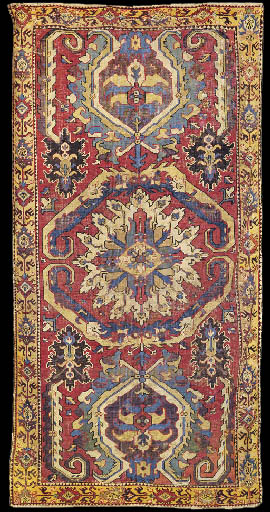|
Early Karabagh
blossom rug, Early Khanate Period, mid18th century, Karabagh Khanate,
Azerbaijan
|
A KARABAGH BLOSSOM CARPET
SOUTH CAUCASUS, 18TH CENTURY
Price Realized £20,900 ($41,236)
Sale Information
Christie's Sale 7572
Oriental Rugs and Carpets
10 April 2008
London, King StreetLot Notes
Lot Description
20-A KARABAGH BLOSSOM CARPET
SOUTH CAUCASUS, 18TH CENTURY
Uneven overall wear, corroded brown, areas of repiling, much of border
rewoven
9ft.4in. x 5ft.1in. (283cm. x 155cm.)
Pre-Lot Text
THE PROPERTY OF A COLLECTOR, TEXAS
Lot Notes
Produced from as early as the late 16th century through to the 18th century,
a group of carpets to which the present example belongs, united by structure
and power of drawing, are believed to have been woven in Karabagh. For a discussion on the origin of this group see C. G.
Ellis, Early Caucasian Rugs, Washington D.C., 1976, pp.10-11. The whole
group has always been subdivided into a number of known design types some of
which contain a variety of details which are inter-related but nevertheless
differ considerably in detail. For a detailed summary of the various design
types see E. H. Kirchheim et al., Orient Stars, Stuttgart and London, 1993,
pp.101-114 and S. Yetkin, Early Caucasian Carpets in Turkey, London, 1978,
vol.II, pp.41-43.
The carpet offered here depicts the Sunburst Blossom or so-called
Transitional design. The red ground of this example is drawn on a vertical
axis with the central sunburst medallion enclosed within large bold cusped
leaves and flanked at each end by stylised hooked palmettes. Rather than
beginning to form a further octagon to enclose these palmettes and to
suggest a repetitive design, the serrated leaves at either end have been
drawn on the vertical axis which flank the palmettes using their hooked ends
to form a frame which better suits a smaller rug format and anticipates the
design of classic 19th century Kazak rugs. |

